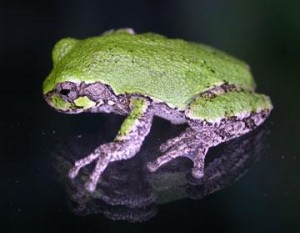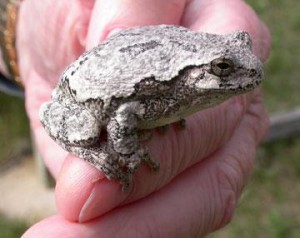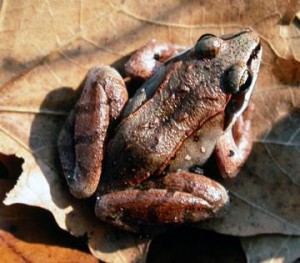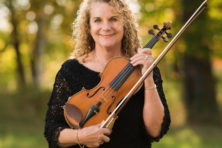Door to Nature
- Share
- Tweet
- Pin
- Share
One of the most important native groups of bioindicators, the frogs, toads and salamanders, soon will be entering the reproductive stages in their life cycles. Some, including the Spring Peepers, Wood Frogs and Leopard Frogs, will be providing us with pleasant and soothing “music” from the wetlands where their eggs will be laid, sure signs of warmer weather to come. Others, like the Blue-spotted, Red-backed and Spotted salamanders, will be perfectly silent as they go about their strange and secretive courtship that will help maintain their populations.
No doubt many of you treasure the nighttime singing of the male frogs and toads usually starting here around mid-April and continuing for several weeks. One of our favorite species, the Wood Frog, also does plenty of “singing” during daytime hours. Their vocalizations remind us somewhat of quacking ducks or even the comical, uneven, cackling voice of the old cartoon character, Mr. Magoo.
Each spring we look forward to stopping at the swamp east of the Kangaroo Lake causeway on our way home following church choir practice in mid-April to listen to the rollicking free-for-all musical renditions of a combination of Wood Frogs, Spring Peepers and Leopard Frogs. A couple dozen Spring Peeper males singing at the same time, competing vigorously for those female Spring Peepers within hearing range, sound like sleigh bells off in the distance. Rubbing a finger over a wet tightly stretched balloon somewhat resembles the low-pitched, guttural, snore-like vocalization of a Northern Leopard Frog.
What is downright mind-boggling are the strategies of some frogs, especially the Wood Frog and Spring Peeper, to withstand below-zero F. temperatures here in the North by freezing solid. The very excellent little booklet, Amphibians of Wisconsin, produced by the Wisconsin DNR and available at area nature centers, provides the following account: “In late fall or early winter, as their body temperatures drop to near 32 degrees F., their metabolisms race for a short period and produce a glycol-like ‘anti-freeze’ that saturates their cells. When temperatures drop below freezing, their body fluid freezes but the cells usually do not. They cease breathing and their entire system shuts down, including the heart. In spring, they literally thaw out and resume activity.”
Three other anurans (tailless amphibians) that appeal greatly, the American Toad, Eastern Gray Treefrog and the Cope’s Treefrog, exist on our property, which is at least one and a half to two miles from the nearest water. How they got here is beyond our understanding. They developed from eggs laid and hatched in water so they must have come the overland route. We see the American Toads in our garden and front flowerbeds. They dig backward into the soft soil, get to below where frost will reach and destroy them and spend the winter there.
My best guess is that both the Gray and the Cope’s Treefrogs freeze solid as do the Spring Peepers and Wood Frogs. One of my favorite songs in nature is that of the Gray Treefrog, a very pleasant musical trill which is often mistaken for the song of a bird. The song of the Cope’s Treefrog is a higher, faster, raspier and not nearly as musical trill. The Cope’s is slightly smaller than the Gray, and often its back is quite a brilliant green color. The Gray can also be somewhat green and always with a dark and light pattern, according to the environment where it is found, but one easily seen field mark distinguishes these two treefrogs. The Gray has a small white patch below each eye. This white patch is missing on the Cope’s Treefrog.
The awesome, sustaining high trill of the American Toad, usually not heard until May and into early June, can sometimes continue for up to 30 seconds. With some practice you should be able to hum a short note, naturally with your mouth open, and whistle at the same time. This in a sense is how the toad makes its far-reaching musical trills. Its vocal pouch below its mouth has been filled with air, appearing like a small balloon, followed by this air supply being slowly forced over its “vocal cords.” What’s so thrilling is to encounter several dozen American Toads all singing at the same, each on a slightly different pitch. This dissonance is downright delightful to hear.
Even though official range maps for our county indicate seven different salamanders, the Mudpuppy, Red-backed, Blue-spotted, Spotted, Eastern Tiger, Four-toed, and the Central Newt, I have encountered only three species, the very common and abundant Red-backed and Blue-Spotted, and the extremely uncommon and rare Four-toed, whose location will remain confidential for obvious reasons. It is fairly common for people who fish for pan fish, especially through the ice in winter, to occasionally hook onto a 12-inch or longer Mudpuppy which the fishermen usually describe as the absolute slimiest object they ever had to remove from a hook. Some people, it has been reported, prefer to cut their fishing leader or line rather than to handle the Mudpuppy.
It was while I was teaching junior high science at Gibraltar years ago that a few of my students each spring would bring in quart fruit jars filled with Blue-spotted and Red-backed Salamanders when we were studying amphibians. At that time apparently small pockets of the swampy swale running north and south parallel to and east of Highway 42 and behind the row of homes still had not been filled in and were teeming with these small three-to-four-inch amphibians.
Forest ponds and swamps, especially when they retain standing water well into summer, are critical during early spring breeding season for these usually very inconspicuous creatures. Following their courtship they head for the surrounding woods to conceal themselves under rotting logs and humus where their food is available including earthworms and various insects.
Like the proverbial “canary in the coal mine” warning the miners of deadly air, the steadily shrinking populations of many of our amphibians signals that people are damaging or destroying the environments required by these small creatures for living, breeding and multiplying naturally. Most are vital to many food chains in nature. Do all you can to sustain or even improve their habitats. Share the landscape with the amphibians. Become a true partner in nature!







